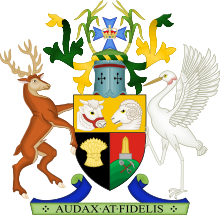| Constitution of Queensland | |
|---|---|
 | |
| Created | 28 December 1867 |
| System | Parliamentary democracy under a constitutional monarchy |
| Government structure | |
| Branches |
|
| Chambers | Legislative Assembly of Queensland |
| Executive | |
| Judiciary | Supreme Court of Queensland and other lower courts |
| Federalism | State within Australia |
| Entrenchments | 6 (all provisions within the Constitution Act 1867 (Qld)) |
| Citation |
|
| Supersedes |
|
The Constitution of Queensland sets out and regulates the powers of the major state institutions of the Australian state of Queensland. It is a written constitution, with most provisions contained within the Constitution of Queensland 2001 (Qld), which consolidated many previous constitutional laws. However, it does not contain all the constitutional principles of the state, with the Constitution Act 1867 (Qld), Australia Act 1986 (Cth), Australian Constitution , the governor's commission, the common law and constitutional conventions also relevant constitutional documents. [1]
Contents
- Function
- History
- Entrenchment and amendments
- See also
- References
- General references
- Specific references
These constitutional documents set down Queensland as a constitutional monarchy operating under the Westminster system, with a parliament composed of the Legislative Assembly and the King exercising legislative powers, an executive made up of ministers and the premier appointed to act on behalf of the governor, and a judiciary made up of the Supreme Court and other lower courts.
Following the Federation of Australia, the colony of Queensland became a state within the new Commonwealth of Australia and ceded certain powers to the Commonwealth Government. However, except where valid Commonwealth laws conflict with the laws of Queensland, the Parliament of Queensland retains plenary legislative power [2]